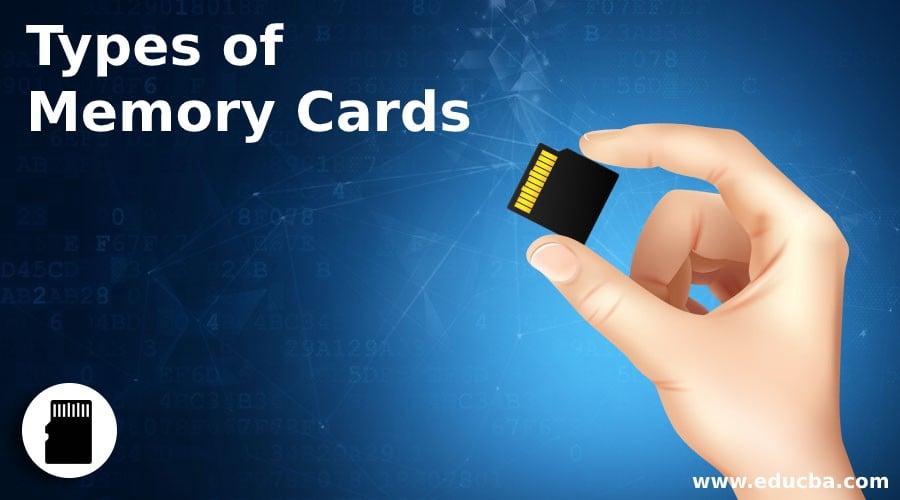Updated May 22, 2023

Introduction to Memory Cards
Memory cards store data in electronic devices such as cell phones, digital cameras, and other handheld devices. This is a non-volatile flash memory meaning even if you remove the card from your device; it won’t lose data. Also, memory cards can be reused and reformatted, and data can be erased from the card. Users should choose a memory card based on capacity, price, and compatibility. It depends on whether the device will support a specific type or specific size of memory card. There are different types of memory cards. Nowadays, cards have become smaller physically but are of larger capacity. The most common types of memory cards are Secure Digital and CompactFlash in Micro and Normal variants.
Various Types of Memory Cards
Given below are the various types :
1. CompactFlash Card
The CompactFlash, also known as CF Card, is used by photographers. CF cards are much more prominent in size than SD cards and are less used. They offer bigger storage, as well as run-time speed is higher.
There are two types of CompactFlash cards which have different capacities:
- Type I Cards: 42.8mm x 36.4mm x 3.3 mm thick.
- Type II Cards: 42.8mm x 36.4mm x 5.5 mm thick.
2. Secure Digital Card
Secure Digital is the basic format of the SD card. The size of the SD card is 32 mm x 24 mm and 2.1 mm thick. These SDHC (Secure Digital High Capacity) cards have a maximum storage capacity of 4GB. The speed of these Cards is less than other SD cards.
3. Secure Digital High Capacity
SDHC (Secure Digital High Capacity) cards are specifically designed to store high-definition photos and videos. The size and shape of this card are the same as a standard SD card. Any SD card that supports 4GB memory is an SDHC card. The storage capacity of SDHC cards is up to 64 GB.
Given below is the list of classes of SDHC cards with minimum speed.
- Class 2 SDHC card supports a Minimum speed of 2 MB/s.
- Class 4 SDHC card supports a Minimum speed of 4 MB/s.
- Class 6 SDHC card supports a Minimum speed of 6 MB/s.
- Class 8 SDHC card supports a Minimum speed of 8 MB/s.
- Class 10 SDHC card supports a Minimum speed of 10 MB/s.
4. Secure Digital Extended Capacity
The Secure Digital Extended Capacity (SDXC) card is a higher version of the SDHC card. Storage Capacity of these cards is 64 GB and can maximize up to 2 TB. Class 1 SDXC card supports a minimum speed of 10 MB/s, whereas Class 3 SDHC card supports a minimum speed of 30 MB/s.
5. Micro Secure Digital High Capacity
The Micro Secure Digital High Capacity (MicroSDHC) card stores data up to 32 GB. Like SDXC, it can transfer up to 10 MB per second.
The Micro Secure Extended Capacity (MicroSDXC) card is the same as the SDXC, which supports storage over 32 GB and up to 2 TB.
It transfers data faster than the MicroSD and MicroSDHC.
6. Extreme Digital Picture Card
The Extreme Digital Picture Card, an xD-Picture Card, is a removable flash memory used in digital cameras. Fuji Film and Olympus develop it. Its size is 20 mm x 25 mm, and a thickness of 1.7 mm.
7. Sony Memory Sticks
Sony Memory Sticks are compact and lightweight storage devices commonly used in various devices, including digital cameras and recorders. They can be utilized with any device compatible with Memory Stick PRO by using an adapter. Memory Stick Micro (M2) is 15 mm x 12.5 mm x 1.2 mm, Whereas Memory Stick PRO is 50 mm x 21.5 mm x 2.8 mm. It is used in high-megapixel digital cameras as well as digital camcorders. The size of Memory Stick PRO DUO is 31 mm x 20 mm x 1.6 mm. The Memory Stick PRO Duo provides advanced features of Memory Stick PRO media.
Conclusion
In this article, we have seen various types of memory cards and their features. You can choose any of the cards based on your requirements, storage capacity, transfer speed, size of a card, and compatibility.
Recommended Articles
We hope that this EDUCBA information on “Types of Memory Cards” was beneficial to you. You can view EDUCBA’s recommended articles for more information.

